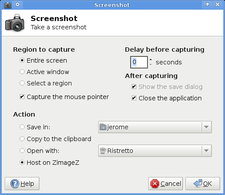Screenshots with Xfce
The Xfce Screenshooter for the Xfce desktop with the current Version 1.6.0 has no cause to fear the competition.
With Version 1.6.0 of Xfce4 Screenshooter, Xfce has gained considerable ground against Gnome and KDE when dealing with screenshot capabilities. The option to choose using the mouse pointer to hide or to display aspects over the graphic user interface is a new one.
When the user deselects the option „Close the application“, the tool remains open after the capture of the screenshot. This is a considerable advantage over Gnome’s screenshot tool, which closes automatically after every screen frame capture. With Gnome, the user is forced to open the application every single time he or she wants to take a new screenshot.
Also, the array of options open to the user after taking a screenshot are nicely designed: the images can be automatically saved in a predetermined folder, opened with specific programs, and can be uploaded to online resource ZimageZ. In the announcement of the new version however, the developers have designated the latter feature as experimental at this point. The user has to create an account with ZimageZ to take advantage of this capability.
In addition, the Xfce4 screenshooter supports features which other desktops offer: the screenshooter can record either defined regions of active windows or from the entire monitor. The application also has an adjustable time invariant. Those who wish to download this tool may find the source code here.
Comments
comments powered by DisqusSubscribe to our Linux Newsletters
Find Linux and Open Source Jobs
Subscribe to our ADMIN Newsletters
Support Our Work
Linux Magazine content is made possible with support from readers like you. Please consider contributing when you’ve found an article to be beneficial.

News
-
Parrot OS Switches to KDE Plasma Desktop
Yet another distro is making the move to the KDE Plasma desktop.
-
TUXEDO Announces Gemini 17
TUXEDO Computers has released the fourth generation of its Gemini laptop with plenty of updates.
-
Two New Distros Adopt Enlightenment
MX Moksha and AV Linux 25 join ranks with Bodhi Linux and embrace the Enlightenment desktop.
-
Solus Linux 4.8 Removes Python 2
Solus Linux 4.8 has been released with the latest Linux kernel, updated desktops, and a key removal.
-
Zorin OS 18 Hits over a Million Downloads
If you doubt Linux isn't gaining popularity, you only have to look at Zorin OS's download numbers.
-
TUXEDO Computers Scraps Snapdragon X1E-Based Laptop
Due to issues with a Snapdragon CPU, TUXEDO Computers has cancelled its plans to release a laptop based on this elite hardware.
-
Debian Unleashes Debian Libre Live
Debian Libre Live keeps your machine free of proprietary software.
-
Valve Announces Pending Release of Steam Machine
Shout it to the heavens: Steam Machine, powered by Linux, is set to arrive in 2026.
-
Happy Birthday, ADMIN Magazine!
ADMIN is celebrating its 15th anniversary with issue #90.
-
Another Linux Malware Discovered
Russian hackers use Hyper-V to hide malware within Linux virtual machines.


the hide pointer feature is not new
But it's ok, I get the picture... Good review...